Silverstone Launches NJ450-SXL Power Supply: Fanless SFX-L, 80Plus Platinum, 450W
by Joe Shields on June 26, 2018 9:15 AM EST- Posted in
- Power Supply
- Fanless
- SilverStone
- 450W
- SFX-L
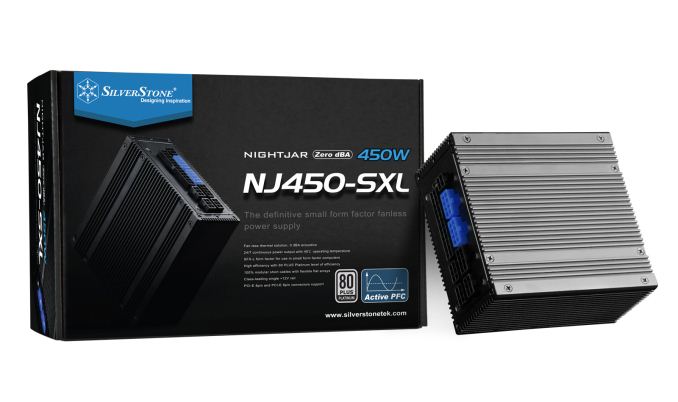
Silverstone has expanded their Nightjar family of power supplies with the addition of a new SFX-L class sized silent PSU, the NJ450-SXL. The new PSU, according to Silverstone, is the first ever fanless SFX-L design. The 450W PSU is said to use premium components, achieves an 80 Plus Platinum level of efficiency, and can output nearly 38A on the +12V rail, all in a fanless 0 dBA aluminum chassis measuring in at 5.12” x 2.5” x 4.92” (WxHxD).
The black chassis is made out of an extruded aluminum shell with fins running front to back on all four panels, serving as a heatsink to remove heat away from the internal components. The other faces of the PSU contain the connectors for outputs and the power plug & on/off switch respectively. The unit does not appear to be vented so the integrated heatsink/chassis will have to do all the work getting the heat out of the device. That said, it is rated to deliver 100% load 24/7 while operating up to 40C.
The Nightjar NJ450-SXL is 100% modular using short flat cables which can make for an easier attempt at hiding the wires. Outside of the 4-pin EPS and four 6/8-pin PCIe connectors measuring in at 400mm/~15-inches, the rest of the cables are 300mm/11.8-inches in length so these may not reach in the largest of cases. Additionally, the NJ450-XSL includes eight SATA connectors, three 4-pin Molex connectors, and a 4-pin legacy floppy connector (100mm length). The power supply can support a single high-end video card or multiple mid-range cards with its connections.
The output on the all-important 12V rail is 37.5A/450W, which is enough to handle many systems, especially HTPC or SFF systems that may not need as much horsepower as other systems. Silverstone has a published GPU support list stating users shouldn’t have an issue powering a PC using even top-of-the-line cards like an NVIDIA GeForce GTX 1080 Ti or AMD Vega 64.
A warranty period isn’t currently listed for the NJ450-XSL but its older cousin, the NJ520 is warranted for three years. The official product page does not provide pricing or availability information. Due to the nature of the unit itself, an 80 Plus platinum SFX-L form factor power supply, it will likely fetch a premium.
| Power Specifications of the Silverstone NJ450-XSL 450W (Rated @ 450W, 40°C) |
|||||
| AC INPUT | 90 - 264 VAC, 47 - 63 Hz | ||||
| RAIL | +3.3V | +5V | +12V | +5Vsb | -12V |
| MAX OUTPUT | 16A | 15A | 37.5A | 2.5A | 0.3A |
| 80W | 450W | 12.5W | 3.6W | ||
| TOTAL | 450W | ||||
| Connectors | 1 x 24/20-pin motherboard connector (300mm) 1 x 8/4-pin EPS/ATX12V connector (400mm) 4 x 8/6-pin PCIe connector (400/150mm x2) 8 x SATA connector (2 x 300/200/100/100mm) 3 x 4-pin Molex connector (300/200/200mm) 1 x 4-pin Floppy connector (100mm) |
||||
| Protections | Over Current Over Power Over Voltage Short Circuit |
||||
| Form Factor | SFX-L 5.12" x 2.5 x 4.92" (WxHxD) | ||||
| Cooling System | Fanless thermal solution | ||||
| MTBF | 100,000 hours | ||||
Related Reading:
- EVGA's Next-Gen Power Supply for SFX: Supernova 650GM
- Corsair Introduces New SF Series and Vengeance Series Power Supplies
- Going Big: EVGA's SuperNova 2000W G+ Power Supply
- ASUS ROG Goes For Power Supplies: ROG THor 1200W Platinum
- FSP Demonstrates Hydro PTM+ 1200 W: a Liquid-Cooled PSU with RGB LEDs
- CES 2016: Deepcool’s Gamer Storm brand Exhibits Water Cooling for a Power Supply
- FSP Dagger 500W and 600W SFX PSUs Come To Market: From $99 with 80Plus Gold


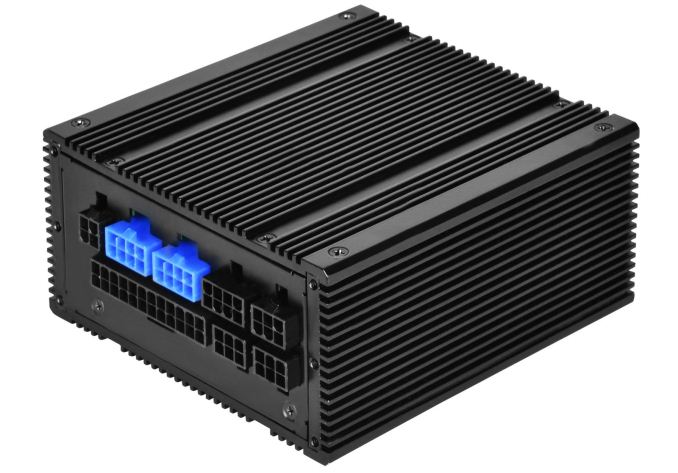
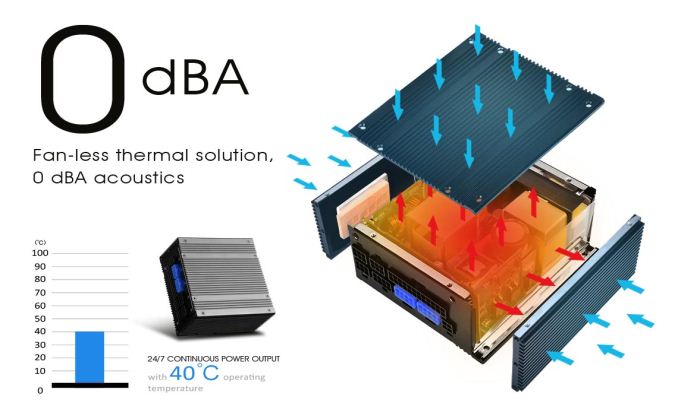
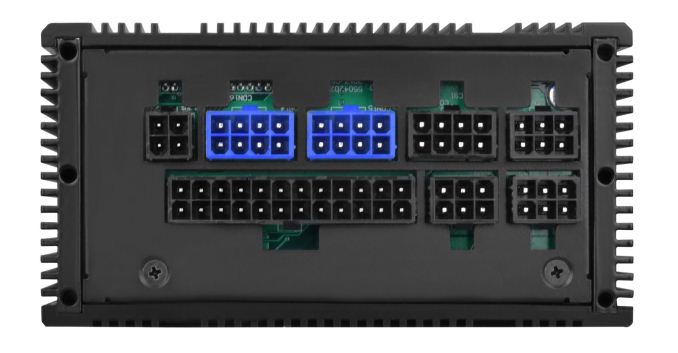
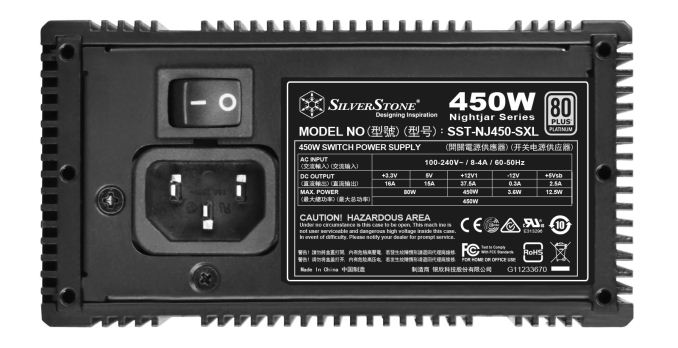








24 Comments
View All Comments
Icehawk - Tuesday, June 26, 2018 - link
I wish this was available two months ago, would have gone ITX instead of mATX, I am all about fanless PSUs - have them in both my desktops and combined with SSD only storage they are whisper quiet.close - Tuesday, June 26, 2018 - link
I wonder why they went for a "sealed" design. This means all the heat is passed on inside the case and to the case panels and none will be vented outside.At 100% load and 80Plus Platinum it means just ~50W to dissipate. But it's still 50W that mostly go inside what's usually an already cramped case.
ingwe - Tuesday, June 26, 2018 - link
I suspect that they do better than the 90% spec at full load. 55 W is too much to dissipate otherwise. I would think that they are close to 94% at load. Most power supplies optimize for lower loads since that is normal operation but these would be optimized to keep the waste heat under a certain envelope. Just my guess though based on my knowledge of heat transfer and not electronics engineering.DanNeely - Tuesday, June 26, 2018 - link
AFAIK that sort of thing is relatively common in fanless models. Take a 900W model, clamp its output to 450W and you've got one whose peak efficiency is at max load. Normally they don't go quite that high though because 900w class parts will have higher non load depedent losses of the sort that kill efficiency at lower loads. OTOH if they started with a 80+ titanium model, chopping half the output that way would still hit platinum at low loads.FreckledTrout - Wednesday, June 27, 2018 - link
That's what I did on my last build for my gaming PC. Took a Seasonic Titanium 850 knowing im pulling 450 watts max. Switched on hybrid mode and in 99% of my use cases the fan never turns on except on reboots for a few seconds. Fanless with some extra overhead, overhead I paid for though.Samus - Wednesday, June 27, 2018 - link
My guess would be most of the FET’s and other heat generating components are directly interfaced through a thermal transfer material to the outer shell. It’s a furnace inside for sure but a controlled thermal envelope none the less.close - Thursday, June 28, 2018 - link
My point wasn't that the heat cannot be controlled, it's that it will dissipate *inside* the computer case. With the PSU case fully closed you have 35-50W of heat pumped into a cramped PC case instead of venting it even passively outside.cbm80 - Tuesday, June 26, 2018 - link
A sealed design has at least one benefit, no dust buildup.With an open design usually air is being forced through the PSU because of negative or positive case pressure.
close - Thursday, June 28, 2018 - link
An open design with passive cooling has approximately 0 chance of serious dust buildup. Passive cooling and convection will almost exclusively take the air in from inside the case and out through the back. With the amount of dust inside the case and the airflow we're talking about you don't have to worry except in extreme cases.But like this you guarantee that a lot of the heat generated by the PSU is dissipated inside your computer making it harder to cool the rest of the components. And if you get a 450W PSU you might have some performance parts in there.
cbm80 - Thursday, June 28, 2018 - link
In a negative pressure case (fans blowing out), air flows through a passive PSU from outside in. The reverse for a positive pressure case. There's no passive cooling. So what difference does it make whether the PSU is open or not?